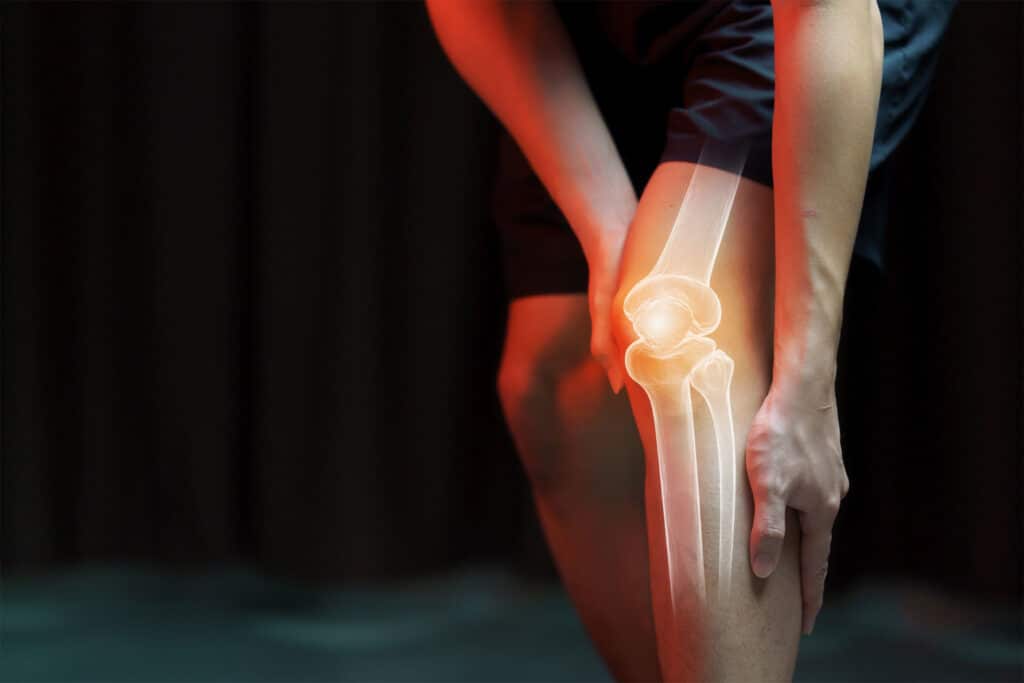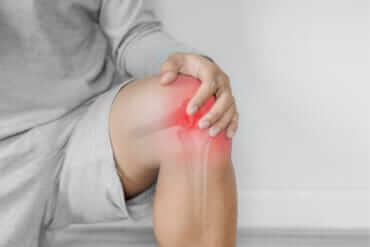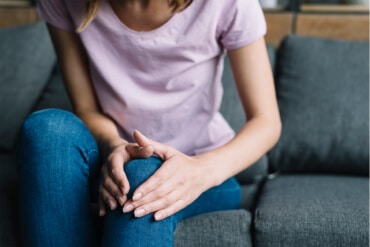Knee Pain
Overview
Knee pain is a common complaint affecting people of all ages. This may be a result of an injury or due to medical conditions such as arthritis, gout, etc, and even infection. The knee joint is made up of bones, ligaments, tendons, cartilage, and bursae. Injury or inflammation of one of these structures can lead to bone and joint issues in the knee. Knee pain can lead to joint damage and lead to low or no mobility if left untreated.
Symptoms associate with knee pain:
-
Swelling and stiffness
-
Redness and warmth to the touch
-
Weakness or instability
-
Popping or crunching noises
-
Inability to fully straighten the knee
-
An obvious deformity in your leg or knee
-
Fever, in addition to redness, pain and swelling in the knee.

Causes of knee pain
Knee pain can result from various causes, and it’s essential to identify the specific reason for accurate diagnosis and appropriate treatment. Conditions commonly linked to knee pain include:
Osteoarthritis (OA): Osteoarthritis is a degenerative joint disease that occurs when the protective cartilage that cushions the ends of bones wears down over time. Causes: Aging, joint injury, obesity, and heredity.
Ligament Injuries: Ligaments are tough bands of tissue that connect bone to bone. Injuries can involve sprains or tears to these ligaments. Common Ligament Injuries are Anterior Cruciate Ligament (ACL) injury, Posterior cruciate ligament (PCL) often occurring during sports or traumatic incidents and Medial Collateral Ligament (MCL) injury.
Pes Anserine Bursitis: Inflammation of the bursa (fluid-filled sac) located on the inner side of the knee, below the joint.
Baker’s Cyst: A Baker’s cyst is a fluid-filled swelling that forms behind the knee.
Rheumatoid Arthritis: An autoimmune disorder causing inflammation of the joints, including the knee.
Knee Pain Treatment Options
A physical exam by an IBAP pain doctor is often the first step to determining the source of pain. Following our doctor’s assessment, imaging tests, including X-rays, and USG scans, may be necessary to help doctors pinpoint the cause of the knee pain and determine the best knee pain treatment plan. Advanced, minimally invasive treatment options for knee pain have improved outcomes and can help you return to the activities you enjoy. The treatment options from the Indo-British Advanced Pain Clinic include our personalised plans with are a combination of the following techniques depending up on the clinical picture.

Regenerative Therapy:
1. Platelet Derivates:
- Platelet-rich plasma (PRP)
- Platelet Rich Fibrin (iPRF)
- Growth Factors Concentrate (Autologous Serum)
2. Exosomes
3. Stem Cell Derivates
- Stromal Vascular Fraction, SVF (Nano Fat)
- Bone Marrow Aspirate Concentrate (BMAC)
- Umbilical Cord Stem Cells
- Allogenic Stem cells (Donor Cells)

Ablation Techniques:
4. Cooled-Radiofrequency Ablation (C-RFA)
5. Conventional RF Ablation
6. Cryoablation
Other techniques:
7. HA injection,
8. Prolotherapy
9. Ozone therapy
10. Laser Therapy
Some quick information
Knee pain can result from several different things including an injury, pulled or torn ligaments and tendons, damaged cartilage, gait, and even muscle and back injuries. Bone and joint pain in the knee may occur following years of wear and tear playing sports, working or from general leisure activities.
Injuries to the knee can affect the cartilage, ligaments, tendons and the bursae (fluid-filled sacs) that support, stabilize and cushion the knee joint. Some common injuries to the knee include:
- ACL injury – The anterior cruciate ligament (ACL) is one of four ligaments in the knee that provides stability to the knee. Most often this ligament is injured with sudden directional changes with the knee bending inward and forward, tearing the ligament. This is frequently seen in football, basketball and skiing injuries.
- Torn meniscus – The meniscus is tough cartilage that acts as the shock absorber between the femur (thigh bone) and the tibia (shin bone). This also can be torn with a sudden twisting injury to the knee.
- Bursitis – There are small sacs of fluid filled cushion that surround the knee joint. When these become irritated and inflamed, pain occurs, especially with movement.
- Loose body – An injury or general wear and tear can cause pieces of bone or cartilage to become loose and break off. The loose body can interfere with the normal movements of the knee and cause pain with movement.
- Patellar tendinitis – This occurs when there is irritation or inflammation of the tendon around the patella (kneecap). Typically, those who run, ski, cycle and take part in sports involving heavy jumping and stress on the knees are prone to this injury.
- Patellar dislocation – The patella (kneecap) covers the front of the knee and glides through the normal range of motion. If the patella becomes dislocated, pain occurs as there is excessive lateral, or side to side, movement of the patella.
Certain medical conditions also lead to knee pain. These conditions may require you to see one of our APM knee pain doctors in Wisconsin. These include:
- Osteoarthritis – This is the most common type of arthritis. This is usually the result of a wear-and-tear injury where the cartilage breaks down over a period of years from use and with age. As the cartilage disappears, the cushion is destroyed and bone on bone grinding can occur, leading to knee pain.
- Rheumatoid arthritis – This is an autoimmune condition that can affect many other joints in the body besides the knee. This is a chronic disease condition and the severity and impact on a patient is variable from mild to severe.
- Gout – This condition results from excessive uric acid crystal build up in the joints of the body. Typically, patients have the big toe affected as well as the knee.
- Pseudogout – This condition is similar to gout, however, there is a build-up of crystals of calcium pyrophosphate instead of uric acid. Knees are commonly affected by this condition.
A person may be more likely to experience certain types of knee pain and knee problems common to their age and sex group. Excess weight increases stress on the knee joints on daily basis. Being involved in sports or having a previous knee injury also increases the chance of experiencing knee pain. Certain activities and sports, such as skiing, basketball and football, tend to create more stress on the knees, causing injury.
A physical exam by IBAP knee pain doctor is often the first step to determine the source of bone and joint pain in the knee. Following a knee pain doctor’s assessment, imaging tests including X-rays, CT scans, ultrasounds and MRIs may be necessary to help doctors pinpoint the cause of the knee pain and determine the best knee pain treatment plan.
Advanced, minimally invasive treatment options for knee pain have improved outcomes and can help you return to the activities you enjoy. The treatment options from the Indo British advanced Pain clinic that can help reduce knee pain include:
- Steroid Injection
- Nerve Blocks
Our goal is to help the patient regain their quality of life
We relieve your pain, helping you be yourself again!

